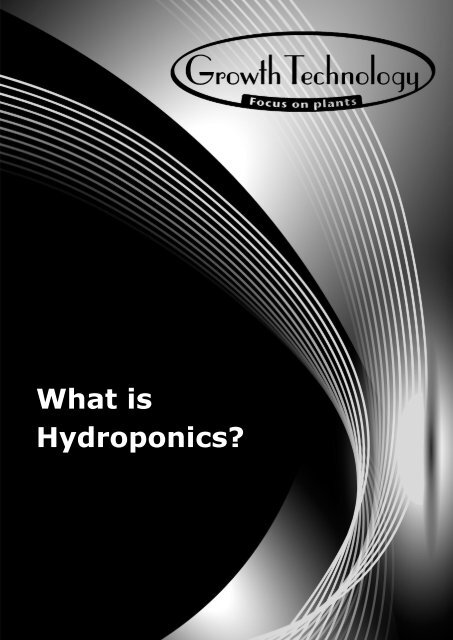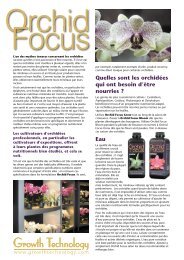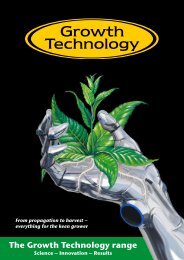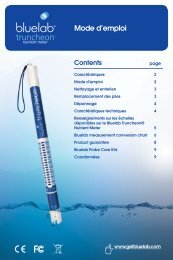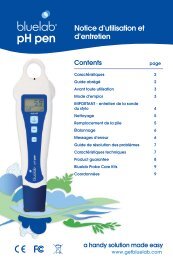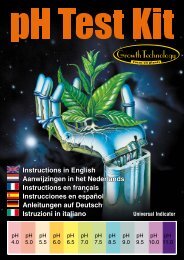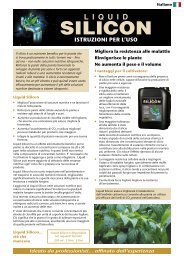What is Hydroponics? - Growth Technology
What is Hydroponics? - Growth Technology
What is Hydroponics? - Growth Technology
Create successful ePaper yourself
Turn your PDF publications into a flip-book with our unique Google optimized e-Paper software.
<strong>What</strong> <strong>is</strong><br />
<strong>Hydroponics</strong>?
Content<br />
Title<br />
Page<br />
<strong>What</strong> <strong>is</strong> Hydroponic growing? 1<br />
Types of Hydroponic Systems 1<br />
Wicks System<br />
Water Culture<br />
Ebb and Flow System<br />
Drip System<br />
N.F.T System<br />
Aeroponic<br />
1<br />
2<br />
2<br />
2<br />
3<br />
3
<strong>What</strong> <strong>is</strong> Hydroponic growing?<br />
<strong>Hydroponics</strong> <strong>is</strong> a subset of hydroculture, which <strong>is</strong> the growing of plants in a soilless medium, or an<br />
aquatic based environment. Hydroponic growing uses mineral nutrient solutions to feed the plants<br />
in water, without soil.<br />
For those of us who love growing plants these are exciting times indeed. We are no longer limited by<br />
climate or by season in the pursuit of our harmless pleasures. We can now grow virtually any plant<br />
at virtually any time of the year – the only limitation <strong>is</strong> our imagination. The simple, effective<br />
hydroponic systems now available , coupled with modern horticultural lighting, have transformed<br />
our hobby and freed us to grow our favourite plants where and when we choose.<br />
Types of Hydroponic systems?<br />
When you think of hydroponics, you instantly imagine plants grown with their roots suspended<br />
directly into water with no growing medium. However th<strong>is</strong> <strong>is</strong> just one type of hydroponic gardening<br />
known as N.F.T. (nutrient film technique). There are several variations of N.F.T. used around the<br />
world and it <strong>is</strong> a very popular method of growing hydroponically. <strong>What</strong> most people don't real<strong>is</strong>e <strong>is</strong><br />
that there are countless methods and variations of hydroponic gardening.<br />
Wicks System<br />
Seen as the most simpl<strong>is</strong>tic hydroponic system. The<br />
Wick system <strong>is</strong> described as a passive system, by<br />
which we mean there are no moving parts. From<br />
the bottom reservoir, your specific <strong>Growth</strong><br />
<strong>Technology</strong> nutrient solution <strong>is</strong> drawn up through a<br />
number of wicks into the growing medium. Th<strong>is</strong><br />
system can use a variety of mediums, perlite, soil<br />
or coco.
Water Culture<br />
Th<strong>is</strong> system <strong>is</strong> an active system with moving parts.<br />
As active hydroponic systems go, water culture <strong>is</strong><br />
the simplest. The roots of the plant are totally<br />
immersed in the water which contains a <strong>Growth</strong><br />
<strong>Technology</strong> nutrient solution. An air pump with help<br />
oxygenate the water and allow the roots to breathe.<br />
NOTE. Very few plants other than lettuce will do well in th<strong>is</strong> type of system.<br />
Ebb and Flow System (Flood and Drain)<br />
Th<strong>is</strong> hydroponic system works by temporarily flooding the grow tray. The nutrient solution from a<br />
reservoir submerges the roots before draining back to the holding tank. Th<strong>is</strong> action <strong>is</strong> usually<br />
automated with a water pump on a timer.<br />
Drip System (recovery or non-recovery)<br />
Dip systems are a widely used hydroponic<br />
method. A timer will control a water pump,<br />
which pumps water and the <strong>Growth</strong> <strong>Technology</strong><br />
nutrient solutions through a network of<br />
elevated water jets. A recovery system will<br />
collect excess nutrient solution back into the<br />
reservoir. A non-recovery drip system will avoid<br />
th<strong>is</strong> allowing the pH of the reservoir not to vary.<br />
If using a recovery system, be sure to check<br />
the pH level of the reservoir regularly and<br />
adjust using either pH UP or pH Down solutions<br />
on a more frequent bas<strong>is</strong>.
N.F.T System<br />
The N.F.T system <strong>is</strong> at the forefront of<br />
people’s minds when hydroponics <strong>is</strong><br />
mentioned. Nutrient Film Technique uses a<br />
constant flow of your <strong>Growth</strong> <strong>Technology</strong><br />
nutrient solution (therefore no timer <strong>is</strong><br />
required). The solution <strong>is</strong> pumped from a<br />
reservoir into the growing tray. The growing<br />
tray requires no growing medium. The roots<br />
draw up the nutrients from the flowing solution. The downward flow pours back into the reservoir to<br />
be recycled again. Pump and electric maintenance <strong>is</strong> essential to avoid system failures, where roots<br />
can dry out rapidly when the flow <strong>is</strong> d<strong>is</strong>turbed.<br />
Aeroponic System<br />
Areoponic systems are seen to be a high tech method of hydroponic growing. Like the N.F.T system<br />
the growing medium <strong>is</strong> primarily air.<br />
The roots hang in the air and are m<strong>is</strong>ted with nutrient<br />
solution. The m<strong>is</strong>ting of roots <strong>is</strong> usually done every few<br />
minutes. The roots will dry out rapidly if the m<strong>is</strong>ting<br />
cycles are interrupted.<br />
A timer controls the nutrient pump much like other<br />
types of hydroponic systems, except the aeroponic<br />
system needs a short cycle timer that runs the pump<br />
for a few seconds every couple of minutes.


